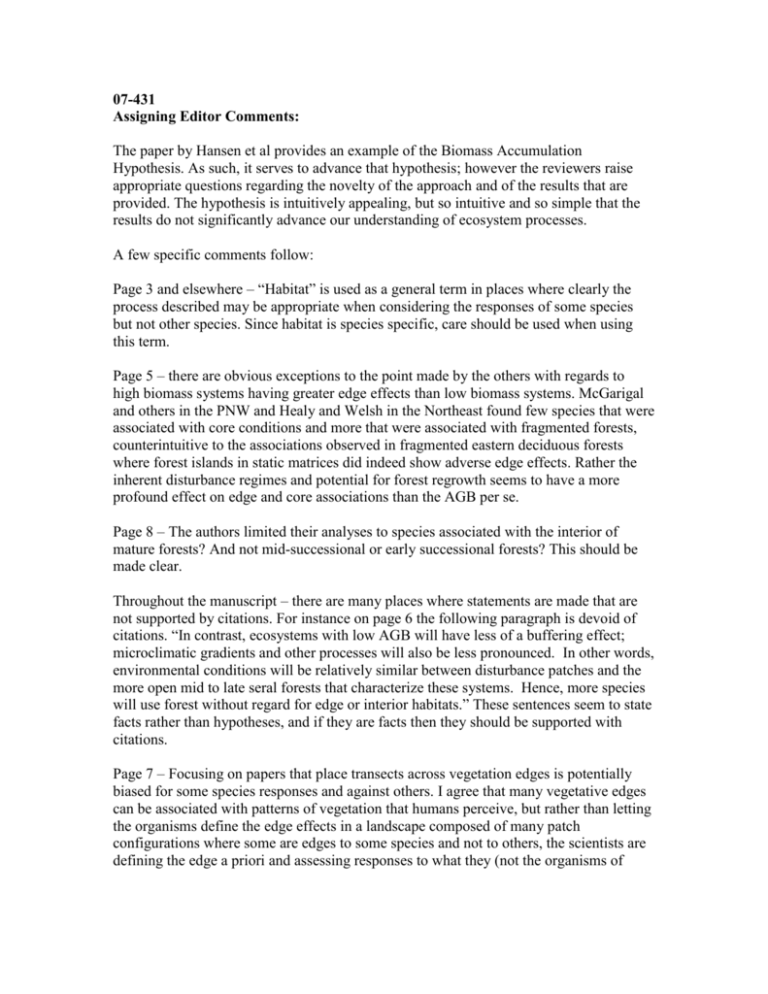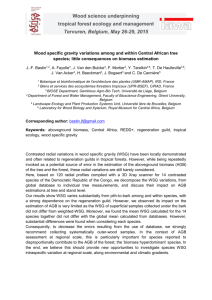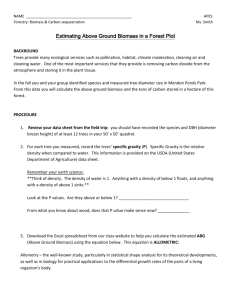Reviews7_431 - Montana State University
advertisement

07-431 Assigning Editor Comments: The paper by Hansen et al provides an example of the Biomass Accumulation Hypothesis. As such, it serves to advance that hypothesis; however the reviewers raise appropriate questions regarding the novelty of the approach and of the results that are provided. The hypothesis is intuitively appealing, but so intuitive and so simple that the results do not significantly advance our understanding of ecosystem processes. A few specific comments follow: Page 3 and elsewhere – “Habitat” is used as a general term in places where clearly the process described may be appropriate when considering the responses of some species but not other species. Since habitat is species specific, care should be used when using this term. Page 5 – there are obvious exceptions to the point made by the others with regards to high biomass systems having greater edge effects than low biomass systems. McGarigal and others in the PNW and Healy and Welsh in the Northeast found few species that were associated with core conditions and more that were associated with fragmented forests, counterintuitive to the associations observed in fragmented eastern deciduous forests where forest islands in static matrices did indeed show adverse edge effects. Rather the inherent disturbance regimes and potential for forest regrowth seems to have a more profound effect on edge and core associations than the AGB per se. Page 8 – The authors limited their analyses to species associated with the interior of mature forests? And not mid-successional or early successional forests? This should be made clear. Throughout the manuscript – there are many places where statements are made that are not supported by citations. For instance on page 6 the following paragraph is devoid of citations. “In contrast, ecosystems with low AGB will have less of a buffering effect; microclimatic gradients and other processes will also be less pronounced. In other words, environmental conditions will be relatively similar between disturbance patches and the more open mid to late seral forests that characterize these systems. Hence, more species will use forest without regard for edge or interior habitats.” These sentences seem to state facts rather than hypotheses, and if they are facts then they should be supported with citations. Page 7 – Focusing on papers that place transects across vegetation edges is potentially biased for some species responses and against others. I agree that many vegetative edges can be associated with patterns of vegetation that humans perceive, but rather than letting the organisms define the edge effects in a landscape composed of many patch configurations where some are edges to some species and not to others, the scientists are defining the edge a priori and assessing responses to what they (not the organisms of interest) perceive as an edge. The results become even more predictable when physical variables such as light are used as response variables. Page 13 – ‘Positively’ is spelled incorrectly and there are other minor proof-reading issues throughout the paper. Given the lack of novelty in the paper I recommend that the authors, at best, be allowed to resubmit a new manuscript for another round of reviews but this one in its current form is not acceptable. Reviewer 1: General comments This paper examines a set of published studies to investigate the relationship between forest biomass and the magnitude of edge effects. Although limited by sample sizes, the analyses and results are relatively straight-forward and clear. I have one general concern about the paper and a few specific comments. My major concern is that the hypothesis being tested is intuitive. Where there is more biomass, there is more of an opportunity for measurable edge effects to develop. More vegetation results in more shade, less wind, and hence the retention of more moisture. The reader needs to be convinced of why this simple concept needs to be tested. Specific comments Page 11, end of first full paragraph. Why does having larger sample sizes for lower AGB forests result in a more conservative test of the hypothesis? Page 12. The relationship between AGB and humidity is weak as it appears to depend on one data point. Likewise, for many of the variables, it appears that sample sizes were too low to be meaningful. Page 14, line 5. Could, or should this be 140 t/ha to match the value on the previous page? Page 17, second paragraph, last line. This doesn’t quite follow from the previous statements. I also think it is important to consider the depth of edge effects here. A small patch in a high AGB forest may experience less habitat alteration than a small patch in a forest of intermediate AGB because the depth of the effect is less (given the hypothesis of a bimodal relationship between depth of effect and AGB). Page 17. Last paragraph, first sentence. This sentence is subjective. I would refrain from using the term “negative”. These effects may be negative for forest interior species, but not for all species. Figure 1. The concept is simple enough that this figure isn’t needed. Figure 2. This figure is not necessary, but if it is kept, it might be more easily interpreted as a three dimensional surface. Reviewer 2: General comments Although most of the conclusions make sense, the data do not support them. The soil moisture regression is too limited, and tropical soils are so fundamentally different from the other forest types, that I would not know how to interpret a difference, anyway. With the analyses of the animal groups, they tested their basic prediction that the proportions of mammal, bird, and beetle interior forest specialists are higher in high AGB forest. However, they appear to interpret this as a MEI analysis, which it isn't. This part of the paper is not a study of edge effects, but is discussed as such. Specific comments Page 9 – Units of measure with regards to biomass should be given early in the discussion. Page 11 -- Are there any figures available in the literature that would provide a context for what constitutes biologically important MEI values? This would be useful for determining the relative importance of these values among the forest types. Figure 4 and page 13 – one outlier observation in the lower chart seems to have significant leverage on the relationship – was this effect of leveraging tested? The spread of the remaining points would seem to make an interpretation of the figure (w/o the outlier) difficult with respect to potential impacts on organisms. Page 14 -- Using data from other studies on the number of forest interior specialists that are known to occur in these forest types without fragmentation (or examined on a landscape basis) would be very useful here, especially given the sample size. Page 15 – re: “Above this AGB level, the percent interior species remained near 30.” This would suggest more of a threshold effect than a simple linear relationship that is shown in the graph, but the sample size is too small to test for that. However, the line on the graph clearly infers a steadily increasing relationship between AGB bird biomass that the data do not. Page 16 – re: “We assume that interior species were poorly represented in low AGB forests because forest interiors and edges did not differ much in microclimate, vegetation structure, and other direct edge effects”. Vegetation structure was not quantified in this study. The only direct biological effect defined in this paper is the change in species abundances between edge and interior forest. Page 16 -- MEI analyses were not conducted for beetles, birds and mammals based on your definition of MEI. From what I can tell, the percent of interior species/all species encountered was quantified, but there is no analysis of the MEI on their relative abundance along the edge-interior gradient. Instead, you are inferring that the MEI on forest interior specialists should be more pronounced in high AGB forests where they occur in higher numbers. Page 17 – Re: “The analysis of species specialization was restricted to beetles, birds, and mammals because too few studies were available for other taxonomic groups.” Why was this part of the analysis restricted to studies of edge effects? The analysis did not evaluate the relative MEI on these groups (e.g., what percent of interior species showed a response to edge effects/fragmentation in high/low AGB forests). The estimation of forest interior species may be underestimated if they became uncommon or absent from these forests following the fragmentation. The sample size can be increased by including studies of intact forest. Further, a similar analysis of the impacts of fragmentation on the abundance/presence of interior species in low-high AGB forests would be a better test of the hypothesis. Figure 1 -- I do not understand the y-axis label. The magnitude (measured as the change between the two habitats) is not low and high, the value of the measured variable within each habitat type is. So, vegetation biomass is low in the early seral patch and high in the late seral stage in the high biomass ecosystem. The lines show the magnitude of the change for each variable but the y-axis represents their values. Figure 3. This graph is missing the y-axis label, tons/ha. ‘s.d.’ should be SD. The asterisk following ‘Temperate Coniferous’ is not necessary.








